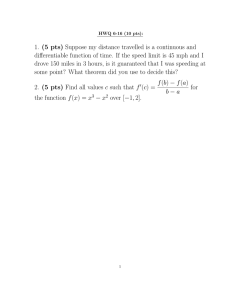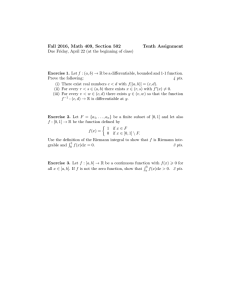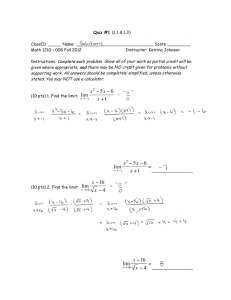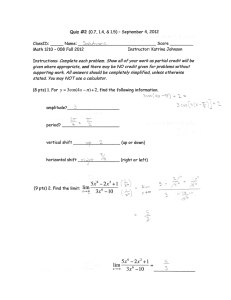(J Math22lO Midterm
advertisement
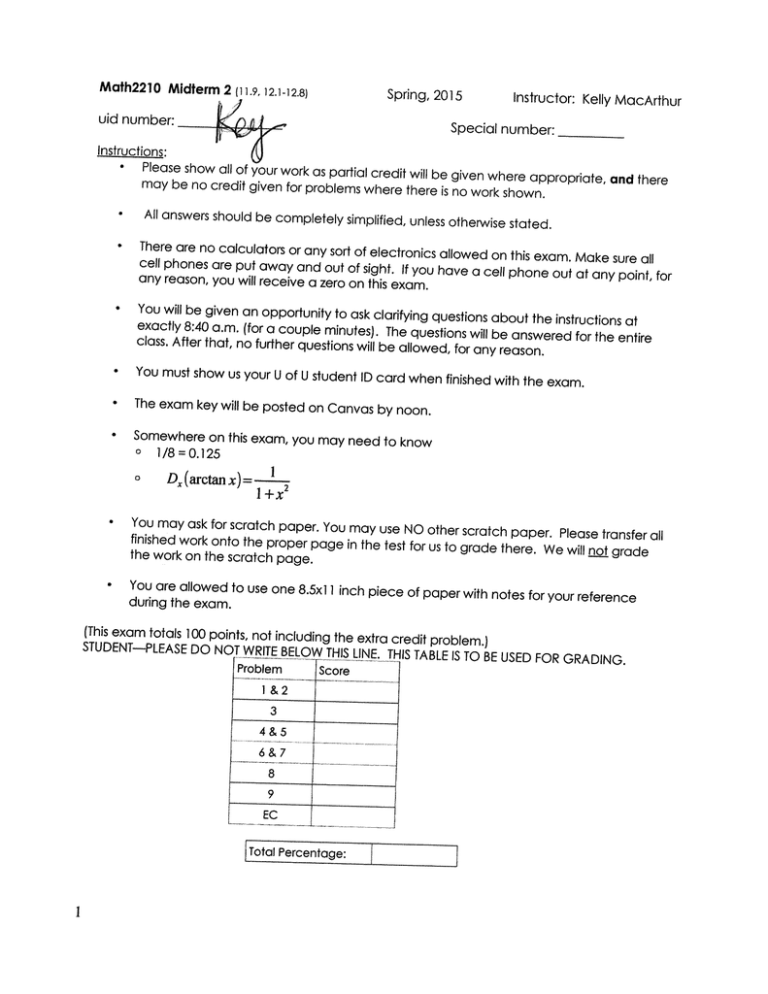
Math22lO Midterm 2(11.9.12.1-12.8) Spring, 2015 uid number: Instructor: Kelly MacArthur Special number: (J Instructions: • Please show all of your work as partial cred it will be given where appropriate, and there may be no credit given for problems where there is no work shown. • All answers should be completely simplified , unless otherwise stated. • There are no calculators or any sort of electronic s allowed on this exam. Make sure all cell phones are put away and out of sight. If you have a cell phone out at any point, for any reason, you will receive a zero on this exam . • You will be given an opportunity to ask clarifying questions about the instructions at exactly 8:40 a.m. (for a couple minutes). The questions will be answered for the entire class. After that, no further questions will be allow ed, for any reason. • You must show us your U of U student ID card when finished with the exam. • The exam key will be posted on Canvas by noon . • Somewhere on this exam, you may need to know o o 1/8=0.125 D(arctanx)= 1 1+x 2 • You may ask for scratch paper. You may use NO other scratch paper. Please transfer all finished work onto the proper page in the test for us to grade there. We will j grade the work on the scratch page. • You are allowed to use one 8.5x1 1 inch piece of paper with notes for your reference during the exam. (This exam totals 100 points, not including the extra credit problem.) STUDENT—PLEASE DO NOT WRITE BELOW THIS LINE. THIS TABLE IS TO BE USED FOR GRADIN G. j-- 1 &2 3 4&5 +——1 8 9 EC Total Percentage: I 1. (12 pis) Find the directional derivative of f(x, y, 3 +4xyz y 2 z)=x — yz at p=(3,0, I) in the direction of a=i—2j+2k 0—0> Of-I — f (3o ) . 4JZL2_ .,V Lz)+ (3i 5(ztl) + Lc) 22 _ 2:2-f Answer: 2. (10 pts) Use the total differential from P(-4, 0.25) to Q(-4.O1, 0.26) for dz to approximate the change in z as (x, y) moves z= arctan(xy) -O2q )[ -) Answer: 2 0 Cr ol) —g,o--iic > L CD D I tJ + -L + --j + \ < r r’J -4- 4 v, CD II N 4-., + CD CD 00 — DD CD— (_) DO os-) OU) E cD_c -OCOc > I C\1 H .? )D . U 0 -c o C?) (1) -4-c, —D - ‘ ‘0 cD Q•Q •c:: -4-- 0 OG) DD ÷- oE -ci) I\ I — —“ zP fr— 1- N rJ - -‘ .- -. ci) -c o C - o U) 0) C ‘4- -c 0 0 ci) -.- , E + .c) -- a 2-- Lr.c I + >. + — * x U- - Cà) - 4, “0 4 t’ 0 0 0 0 It T C 6. (10 pts) Given questions. 2 w(x,y) — 3 xy-i-2y =2x x = 3 u—v , y=uv — LA) 8w (b) Find when u=—3 , v=—2 . _L1)-—I -3L—J’ . f2 i_ - Answer: 7. (10 pts) Find the limit, if it exists. (Show all your reasoning.) 3x—4y urn (x,y)—.(O,O) 2x+y x o; j2 2 -p: ‘1) 1X+ Answer : 5 , answer these 8w that you need to use for this problem. 8u (a) Write out the chain rule for x . > 4 09 - CD D 4i — CD CD C) 0 Lfl 0 -4- CD -4- a C-) 0 0 -‘ 0 Q5 D cA - < CD 0 cic 0 -, 0— (p - (2 r ii cc f-c D 0 D D -40 0 C) 0 0 ci D 0 -4CD CD -Q C 0 -4- 0• CD ‘I, -4- 0 C-) 0 3 0 CDI ci” C) 0-I- I! CD 3 y)=x 9. (13 pts) Find all critical and saddle points for 2 2 +y 3x + 2y +4 f (x, Determine whether each point is a minimum, maximum or saddle point. = X’Y -O 1 (JV’0i e) .:=) c L° z. (-) 0 -i) I 12(?)_[i2->0 C4- C2-1) (\fLY ‘ -cw).-(>2 0 H-3Lo) 2 ’ 3 L2)’’ Critical point(s) (Specify whether they’re mm, max or saddle.): Note: Give FULL 3-d points. (_Q-L ) (2)d)-( 7 — s”AAQ. Extra Credit: (5 pts) Answer each of these short answer questions. 1. Circle all of the following statements that are true. (lt s possible more than one of these t statements is correct.) Jhe vector <f(x, y) f ,(x, y) 1 z=f(x,y) atthe point(x,y). , , —1> is perpendicular to the surlace (b) The vector <f(x, y) f(x, y)> is perpendicular to the surface z—f(x, y) at the point (x, y). , ljhe vector <f(x,y), f(x, y)> is perpendicular to the level curve of the ace z—f(x, y) at the point (x, y). 2. Which of the foVowing two statements is true? (circle one) (a) 1ff is continuous at (x, y), then it’s differentiable there. f is differentiable at (x, y), then it’s continuous there. 3. If Iinif(y,y)L then y—O urn f(x,y)=—L (x,y)—’(O,O) True 4. The level curves for or (circle one) zg25 2 -y —2x are circles. True or ccircie one) If your answer is false, then state what shape the level curves ore: a 2±? 8 2-SE
